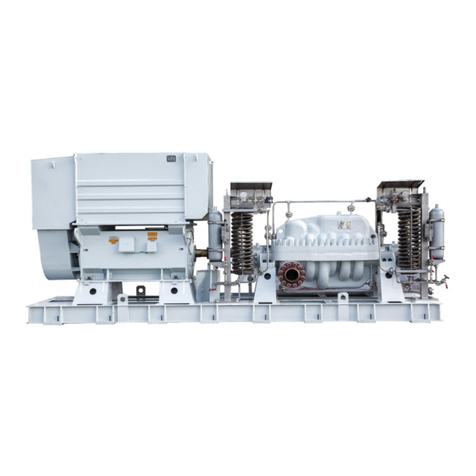
9
.Only use the pump to handle the uids specied in the data sheet or product literature of the
respective design variant.
.Never operate the pump without the uid to be handled.
.Observe the minimum ow rates indicated in the data sheet or product literature
(to prevent overheating, bearing damage, etc).
.Observe the maximum ow rates indicated in the data sheet or product literature (to prevent
overheating, mechanical seal damage, cavitation damage, bearing damage, etc).
.Do not throttle the ow rate on the suction side of the pump (to prevent cavitation damage).
.Consult the manufacturer about any use or mode of operation not described in the dat
a sheet or product literature.
Prevention of foreseeable misuse
.Never open discharge-side shut-o elements further than permitted.
– The maximum ow rate specied in the data sheet or product literature would be exceeded.
– Risk of cavitation damage
.Never exceed the permissible operating limits specied in the data sheet or product literature
regarding pressure, temperature, etc.
.Observe all safety information and instructions in this manual.
2.4 Personnel qualification and training
All personnel involved must be fully qualied to install, operate, maintain and inspect the
machinery this manual refers to.
The responsibilities, competence and supervision of all personnel involved in installation,
operation, maintenance and inspection must be clearly dened by the operator.
Decits in knowledge must be rectied by suciently trained specialist personnel training
and instructing the personnel who will carry out the respective tasks. If required, the operator
can commission the manufacturer/supplier to train the personnel.
Training on the pump (set) must always be supervised by technical specialist personnel.
2.5 Consequences and risks caused by non-compliance with these operating instructions
. Non-compliance with these operating instructions will lead to forfeiture of warranty cover
and of any and all rights to claims for damages.
. Non-compliance can, for example, have the following consequences:
– Hazards to persons due to electrical, thermal, mechanical and chemical eects and explosions
– Failure of important product functions
– Failure of prescribed maintenance and servicing practices
– Hazard to the environment due to leakage of hazardous substances
2.6 Safety awareness
In addition to the safety information contained in this manual and the intended use, the
following safety regulations shall be complied with:
.Accident prevention, health and safety regulations
.Explosion protection regulations
2 Safety




























